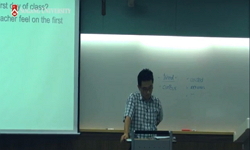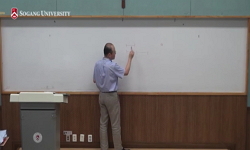This study deals with prominence in terms of New Testament discourse. Prominence theory is one of the issues that has been continually discussed in discourse analysis. Such a concern is legitimate because it would be impossible to understand a text wi...
http://chineseinput.net/에서 pinyin(병음)방식으로 중국어를 변환할 수 있습니다.
변환된 중국어를 복사하여 사용하시면 됩니다.
- 中文 을 입력하시려면 zhongwen을 입력하시고 space를누르시면됩니다.
- 北京 을 입력하시려면 beijing을 입력하시고 space를 누르시면 됩니다.
https://www.riss.kr/link?id=A100091501
- 저자
- 발행기관
- 학술지명
- 권호사항
-
발행연도
2010
-
작성언어
-
-
주제어
배경지식 ; 담화 ; 틀 ; 현저성 ; 문장구조 ; 어순 background knowledge ; discourse ; frame ; prominence ; sentence structure ; word order
-
KDC
231
-
등재정보
KCI등재
-
자료형태
학술저널
-
수록면
309-335(27쪽)
-
KCI 피인용횟수
3
- DOI식별코드
- 제공처
-
0
상세조회 -
0
다운로드
부가정보
다국어 초록 (Multilingual Abstract)
In order to take into account what sort of prominence markers the New Testament Greek has, it is important to keep in mind that a text consists of such various categories as language, grammar, syntax, pragmatics and semantics. So, the determination of prominence markers must be made on the basis of those units. this paper focuses upon four ones as categories to create prominence in Greek New Testament discourse.
1. Repetitive occurrence of paragraph boundary markers such as places and characters
2. Such linguistic expressions as ἐγω, σύ, αὐτός (emphatic) αὐτός jκαί ἰδού
3. Grammatical indicators as word order(noun+adverbial, noun+ possessive noun, demonstrative pronoun+noun), clause/sentence structure (the order of subject, verb and object); verbal aspect (perfective, imperfective and stative aspect); passive voice; Greek article.
4. Semantic/cognitive prominence as unexpected information in terms of frame knowledge
In particular, the major contribution of the present paper is to bring the concept of cognitive model such as frame into the topic of prominence.
This study deals with prominence in terms of New Testament discourse. Prominence theory is one of the issues that has been continually discussed in discourse analysis. Such a concern is legitimate because it would be impossible to understand a text without recognizing prominence markers in it, and because it also impossible to understand a text of which all of information has been focalized. It is fair to say that an readable and understandable discourse is the one that contains unmarked (or background) and marked (prominent) information in an appropriate portion. Likewise, it is also significant for language users to be capable of being familiar with various prominence markers in discourse. The present study is intended to enhance modern biblical exegetes' ability to process and understand the New Testament texts in term of prominence
In order to take into account what sort of prominence markers the New Testament Greek has, it is important to keep in mind that a text consists of such various categories as language, grammar, syntax, pragmatics and semantics. So, the determination of prominence markers must be made on the basis of those units. this paper focuses upon four ones as categories to create prominence in Greek New Testament discourse.
1. Repetitive occurrence of paragraph boundary markers such as places and characters
2. Such linguistic expressions as ἐγω, σύ, αὐτός (emphatic) αὐτός jκαί ἰδού
3. Grammatical indicators as word order(noun+adverbial, noun+ possessive noun, demonstrative pronoun+noun), clause/sentence structure (the order of subject, verb and object); verbal aspect (perfective, imperfective and stative aspect); passive voice; Greek article.
4. Semantic/cognitive prominence as unexpected information in terms of frame knowledge
In particular, the major contribution of the present paper is to bring the concept of cognitive model such as frame into the topic of prominence.
참고문헌 (Reference)
1 박윤만, "틀 이론에 기초한 마가의 구술-청각 서사의 문단연구. in: 언어의 문법화와 문법화의 언어학" 141-142, 2009
2 Y. Tsuji, "인지언어학 키워드 사전" 한국 문학사 252-, 2004
3 한국외대 언어 연구소, "언어의 문법화와 문법화의 언어학" 1-66, 2009
4 Stanley E. Porter, "Verbal Aspect in the Greek of the New Testament, with Reference to Tense and M" Peter Lang 1989
5 Buist M. Fanning, "Verbal Aspect in New Testament Greek" Clarendon 1990
6 N.T. Wright, "The Resurrection of the Son of God" Fortress 356-360, 2003
7 Wallace Chafe, "The Flow of Thought and the Flow of Language. in: Syntax and Semantics" Academic Press 176-180, 1979
8 K. Callow, "The Disappearing de, in 1 Corinthians. in: Linguistics and New Testament Interpretation Essays on Discourse Analysis" Broadman Press 183-193,
9 Stephanie Black, "Sentence Conjunction in the Gospel of Matthew: kai,, de,, to,te, ga,r , ou=n and Asyndeton in Narrative Discourse" Sheffield Academic Press 259-, 2002
10 Brendan Byrne, S.J., "Romans" A Michael Glazier Book 227-228, 1996
1 박윤만, "틀 이론에 기초한 마가의 구술-청각 서사의 문단연구. in: 언어의 문법화와 문법화의 언어학" 141-142, 2009
2 Y. Tsuji, "인지언어학 키워드 사전" 한국 문학사 252-, 2004
3 한국외대 언어 연구소, "언어의 문법화와 문법화의 언어학" 1-66, 2009
4 Stanley E. Porter, "Verbal Aspect in the Greek of the New Testament, with Reference to Tense and M" Peter Lang 1989
5 Buist M. Fanning, "Verbal Aspect in New Testament Greek" Clarendon 1990
6 N.T. Wright, "The Resurrection of the Son of God" Fortress 356-360, 2003
7 Wallace Chafe, "The Flow of Thought and the Flow of Language. in: Syntax and Semantics" Academic Press 176-180, 1979
8 K. Callow, "The Disappearing de, in 1 Corinthians. in: Linguistics and New Testament Interpretation Essays on Discourse Analysis" Broadman Press 183-193,
9 Stephanie Black, "Sentence Conjunction in the Gospel of Matthew: kai,, de,, to,te, ga,r , ou=n and Asyndeton in Narrative Discourse" Sheffield Academic Press 259-, 2002
10 Brendan Byrne, S.J., "Romans" A Michael Glazier Book 227-228, 1996
11 Yoon-Man Park, "Mark's Memory Resources and the Controversy Stories: An Application of Frame Theory of Cognitive Science into the Markan Oral and Oral Narrative" Brill 184-185, 2010
12 Joel Marcus, "Mark 1-8" Doubleday 225-, 1999
13 Stanley E. Porter, "Idioms of the Greek New Testament" Sheffield Academic Press 1994
14 Jeffrey T. Reed, "Identifying Theme in the New Testament: Insights From Discourse Analysis. in: Discourse Analysis and other Topics in Biblical Greek" Sheffield Academic Press 75-101, 1995
15 Robert E. Longacre, "Discourse Peak as Zone of Turbulence. in: Beyond the Sentence: Discourse and Sentential Form" Karoma 83-, 1985
16 Stephen H. Levinsohn, "Discourse Features of New Testament Greek" Summer Institute of Linguistics 99-, 1992
17 K. Callow, "Discourse Considerations in Translating the Word of God" Zondervan 54-, 1974
18 Robert Howard, "Concept and Schemata: An Introduction" Cassell 39-, 1987
19 William Croft, "Cognitive Linguistics" Cambridge University Press 14-, 1974
20 H.E. Dana, "A Manual Grammar of The Greek New Testament" Macmillan 250-252, 1927
21 A.T. Robertson, "A Grammar of the Greek New Testament in the Light of Historical Research" Nashville: Broadman Press 287-, 1934
동일학술지(권/호) 다른 논문
-
Die Christologie der Offenbarung des Johannes
- 한국복음주의신약학회
- 박두환(Doo-Hwan Park)
- 2010
- KCI등재
-
- 한국복음주의신약학회
- 박정식(Park, Jung Sig)
- 2010
- KCI등재
-
- 한국복음주의신약학회
- 이준호(Lee, Joon-ho)
- 2010
- KCI등재
-
- 한국복음주의신약학회
- 이한수(Han Soo Lee)
- 2010
- KCI등재
분석정보
인용정보 인용지수 설명보기
학술지 이력
| 연월일 | 이력구분 | 이력상세 | 등재구분 |
|---|---|---|---|
| 2023 | 평가예정 | 재인증평가 신청대상 (재인증) | |
| 2020-01-01 | 평가 | 등재학술지 선정 (재인증) |  |
| 2019-12-01 | 평가 | 등재후보로 하락 (계속평가) |  |
| 2016-01-01 | 평가 | 등재학술지 유지 (계속평가) |  |
| 2012-01-01 | 평가 | 등재학술지 선정 (등재후보2차) |  |
| 2011-01-01 | 평가 | 등재후보 1차 PASS (등재후보1차) |  |
| 2009-06-19 | 학회명변경 | 영문명 : 미등록 -> Korean Evangelical Society of New Testament Studies |  |
| 2009-01-01 | 평가 | 등재후보학술지 선정 (신규평가) |  |
학술지 인용정보
| 기준연도 | WOS-KCI 통합IF(2년) | KCIF(2년) | KCIF(3년) |
|---|---|---|---|
| 2016 | 0.48 | 0.48 | 0.38 |
| KCIF(4년) | KCIF(5년) | 중심성지수(3년) | 즉시성지수 |
| 0.33 | 0.27 | 0.729 | 0.2 |




 KCI
KCI 스콜라
스콜라






